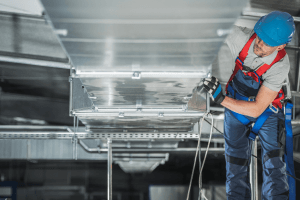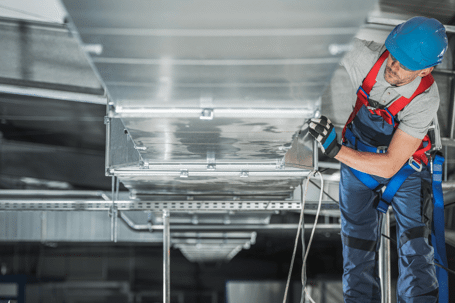HVAC ducts are integral components of your home’s heating, ventilation, and air conditioning system, serving as pathways for air to travel throughout your space. A duct insulation service is not just a mere improvement; it’s a necessity for numerous reasons.

If you’re aiming to maximize the performance of your HVAC system and cut down on energy costs, insulating your ductwork is an essential step. In the following guide, we’ll provide you with a step-by-step approach to effectively insulate your HVAC ducts, ensuring your home is more comfortable, energy-efficient, and quiet.
1. Prepare Your Materials
Before you start insulating your HVAC ducts, gather the necessary materials:
- Insulation Material: Choose an appropriate insulation material, such as fiberglass, foam board, or reflective foil insulation. The choice depends on your specific needs and budget.
- HVAC Foil Tape: High-quality HVAC foil tape is essential for securing the insulation in place and creating an airtight seal.
- Utility Knife or Scissors: You’ll need a utility knife or scissors to cut the insulation to the required size.
- Duct Mastic: 1 Gal. duct sealant mastic and throw away painters brushes to apply.
- Safety Gear: Don’t forget safety gear, including gloves, goggles, and a dust mask, to protect yourself during the insulation process.
2. Clean the Ductwork
Start by thoroughly cleaning the duct surfaces to remove any dust, debris, or contaminants that may hinder the adhesion of the insulation material. A clean surface ensures a secure and effective insulation installation, allowing your HVAC system to operate at its peak efficiency.
3. Measure and Cut Insulation
Accurately measure the length of the duct, taking care to ensure the insulation will fit snugly without gaps. Use a utility knife or scissors to cut the insulation material to the required size, allowing for a slight overlap to create a secure seal. This meticulous approach ensures that your insulation covers the ductwork effectively, optimizing your HVAC system’s performance and energy efficiency.
4. Apply Insulation
Carefully wrap the insulation around the duct, ensuring a snug fit without any gaps or creases that could compromise its effectiveness. Use high-quality HVAC foil tape to secure the insulation in place and create an airtight seal, preventing heat loss or gain during the transportation of conditioned air. This step is essential in maintaining the efficiency of your HVAC system and ensuring a comfortable indoor environment in your home.
5. Seal Joints and Gaps
Inspect the ductwork for any joints or gaps that may have been missed during insulation. Use HVAC foil tape to seal these joints and gaps securely, ensuring that your ductwork remains airtight. By paying attention to these details, you prevent energy loss and maintain the efficiency of your HVAC system, ultimately leading to cost savings and a more comfortable living environment. This meticulous approach is not just about improving air flow; it’s a smart strategy to save money by sealing your HVAC ducts. Sealed ducts reduce the workload on your HVAC system, lower energy consumption, and ultimately lead to significant cost savings on utility bills.
6. Apply Mastic Joints
Apply duct mastic with a throw away painter brush to all tape joints on the insulation. The mastic should cover all the tape and an inch past on either side. The tape will hold the insulation in place until the mastic hardens like a cast. This is the best sealing process for insulation as it does not rely on the tape for a long term seal.
7. Repeat for All Ducts
Continue the insulation process for all the ducts in your HVAC system, including supply and return ducts. By repeating this process diligently, you ensure that every part of your ductwork receives the attention and care it needs, ultimately leading to a more efficient and effective heating and cooling system for your home or business. Consistency in maintenance is key to keeping your HVAC system running smoothly.
8. Test for Air Leaks
Once the insulation is in place, perform a thorough inspection to ensure there are no air leaks. Use a smoke pencil or an infrared thermometer to check for temperature variations. Identifying and sealing any leaks helps prevent conditioned air from escaping, ensuring your heating and cooling efforts are not wasted.
9. Replace Duct Insulation
If your existing duct insulation is damaged or inadequate, consider replacing it for maximum efficiency. Properly insulating your ducts helps maintain temperature consistency, reduces energy waste, and ensures your heating and cooling systems work optimally.
By following these steps, you can effectively insulate your HVAC ducts and enjoy improved energy efficiency, comfort, and reduced noise levels in your home. Remember that proper insulation is essential for maintaining an efficient HVAC system and ultimately saving on energy costs.
Some Common Mistakes to Avoid
When it comes to insulating HVAC ducts, there are several common mistakes that homeowners often make. Being aware of these pitfalls and knowing how to avoid them is important for the success of your insulation project.
Failing to Achieve a Proper Seal
One common error is not sealing the ducts effectively. Even with high-quality insulation, unsealed gaps or openings render the effort futile. Use quality HVAC foil tape and meticulously check the seams for airtightness.
Choosing the Wrong Insulation Material
Using inappropriate insulation can lead to inefficiencies and potential safety hazards. Select material suitable for your HVAC system and the local climate conditions.
Inadequate Insulation Coverage
Another mistake is cutting insulation too short or not allowing sufficient overlap, leading to poor coverage. Accurate measurements are vital to ensure full coverage of the duct surface.
Benefits of Insulating HVAC Ducts
Insulating HVAC ducts is crucial for multiple reasons: it maintains the desired air temperature, preventing heat loss in heating and heat gain in cooling systems, which is vital for comfort during extreme weather. It enhances energy efficiency by reducing the need for the HVAC system to overwork, thereby lowering energy consumption and utility bills. Insulated ducts also create a more consistent and comfortable indoor environment, reduce noise pollution, and protect the ductwork from moisture and damage. This results in an extended lifespan of the HVAC system and savings on repairs or replacements.
Additionally, homeowners can benefit from energy rebates and tax incentives. For instance, Atlanta’s Georgia Power offers rebates for upgrading HVAC insulation and other energy-efficient improvements. Homeowners may also be eligible for federal tax credits for certain energy-efficient upgrades. These incentives help reduce overall energy consumption and save on energy bills.
When to Hire a Pro?
When it comes to enhancing the energy efficiency of your HVAC system, there’s no substitute for the expertise and guidance of duct sealing and insulation technicians like R.S. Andrews. We have the knowledge, experience, and commitment to help you make the right choices for your specific needs, ensuring a more comfortable and sustainable living or working environment.
Investing in an energy-efficient HVAC upgrade is not just about saving on utility bills; it’s a step toward a greener and more environmentally responsible future. By contacting us today, you’re taking the first proactive step toward a more energy-efficient, cost-effective, and eco-friendly HVAC system.
Don’t hesitate to reach out to enjoy the benefits of a more comfortable and sustainable tomorrow.

